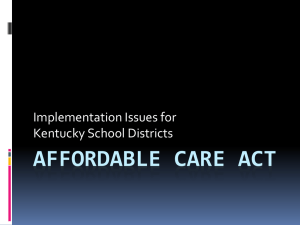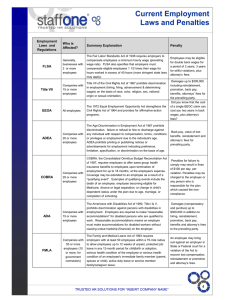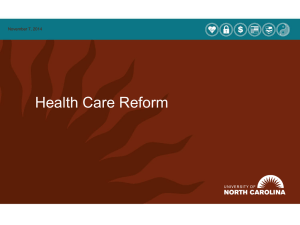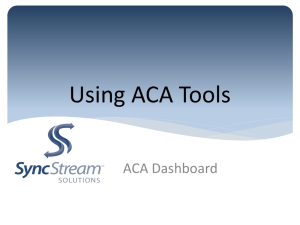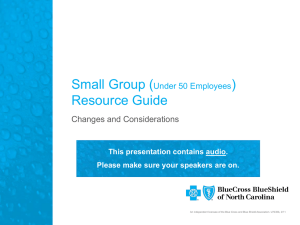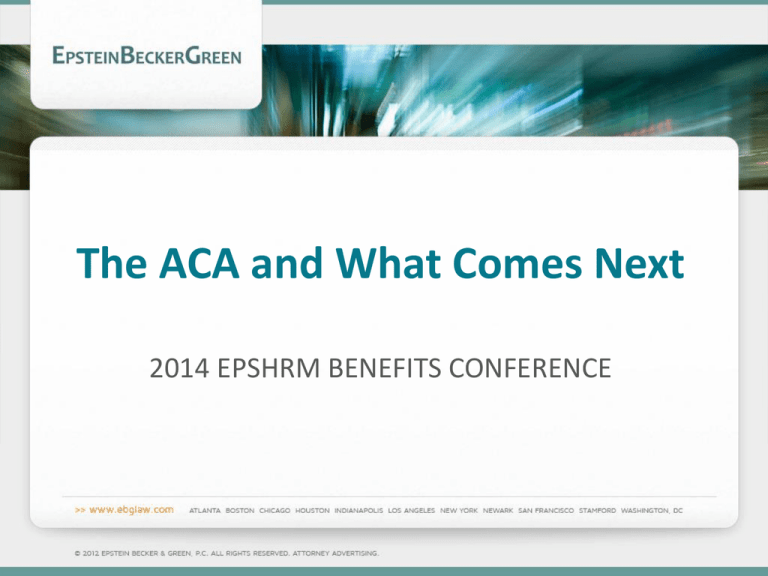
The ACA and What Comes Next
2014 EPSHRM BENEFITS CONFERENCE
This presentation has been provided for informational
purposes only and is not intended and should not be
construed to constitute legal advice. Please consult your
attorneys in connection with any fact-specific situation
under federal, state, and/or local laws that may impose
additional obligations on you and your company.
Attorney Advertising
© 2014 EPSTEIN BECKER GREEN, P.C. ALL RIGHTS RESERVED. ATTORNEY ADVERTISING.
Agenda /
1.
Shared Responsibility
Determining applicable large employer status
Determining full-time employees
Determining liability
The impact of final rules
2.
What's Next
ERISA 510
Scams
Halbig
Cadillac Tax
Exchanges
3.
© 2014 EPSTEIN BECKER GREEN, P.C. ALL RIGHTS RESERVED. ATTORNEY ADVERTISING.
Closing Remarks
ACA Implementation /
EMPLOYER MANDATE DELAY
• Three ACA requirements were delayed:
Section 4980H of
IRS Code
Section 6056 of
IRS Code
Section 6055 of
IRS Code
Employer shared
responsibility provisions
Information reporting
requirements which are
linked to employer
mandate
Information reporting
requirements which apply
to self-insuring employers,
insurers, and certain other
providers of “minimum
essential coverage”
• The delay is over, for most employers compliance begins 1/1/15
© 2014 EPSTEIN BECKER GREEN, P.C. ALL RIGHTS RESERVED. ATTORNEY ADVERTISING.
ACA Implementation /
EMPLOYER MANDATE ANALYSIS
Step 1
Does This Apply to
My Business?
Step 2
To Whom Must I
Offer Coverage?
Step 3
Is My Coverage
Affordable?
Does My Coverage
Provide MV?
Step 4
What is The Cost of
Not Providing
Coverage?
What are the NonEconomic Factors
at Play?
© 2014 EPSTEIN BECKER GREEN, P.C. ALL RIGHTS RESERVED. ATTORNEY ADVERTISING.
Shared Responsibility /
THE BASIC IDEA
Shared Responsibility provides that “Applicable Large Employers” with
50 or more Full-Time (including Full-Time Equivalent) employees are
subject to a tax penalty if any Full-Time Employee receives a premium
tax credit or cost-sharing reduction to purchase coverage through an
Exchange
Full-Time employee is eligible for a cost sharing subsidy if:
An employer does not “Offer” Full-Time employees (and their
dependents) the opportunity to enroll; or
An employer offers its Full-Time employees the opportunity to
enroll but coverage is “Unaffordable” or does not provide
“Minimum Value”
© 2014 EPSTEIN BECKER GREEN, P.C. ALL RIGHTS RESERVED. ATTORNEY ADVERTISING.
SHARED RESPONSIBILITY:
Does This Apply to
My Business?
© 2014 EPSTEIN BECKER GREEN, P.C. ALL RIGHTS RESERVED. ATTORNEY ADVERTISING.
Applicable Large Employer /
QUALIFICATION CRITERIA
Applicable Large Employer (ALE)=
50 or more full-time employees* or
Combination of full-time and part-time employees that equals 50
“full-time equivalent employees”
“Full-time equivalent employees” only relevant for purposes
of determining ALE
Penalties are based only on full-time employees
ALE is determined based on actual hours worked by employees
in the prior calendar year
© 2014 EPSTEIN BECKER GREEN, P.C. ALL RIGHTS RESERVED. ATTORNEY ADVERTISING.
Applicable Large Employer /
TRANSITION RELIEF
For 2015 only: an employer with 50 to 99 full-time employees
or equivalents does not need to comply with the Employer
Mandate
To Qualify for Transitional Relief:
Cannot reduce the size of workforce or overall hours of service
Cannot eliminate or materially reduce any health coverage
offered as of February 9, 2014
© 2014 EPSTEIN BECKER GREEN, P.C. ALL RIGHTS RESERVED. ATTORNEY ADVERTISING.
Applicable Large Employer /
CALCULATING EMPLOYER STATUS
FTE: for each month in the prior year, an employer must total
the number of hours worked by part-time employees and
divide by 120. Then add to number of full-time employees.
The final regulations allow employers to round the to the nearest
hundredth
Example: an employer with 30.544 full-time equivalents in a calendar
month may round this figure to 30.54
Timing: Employers are to make these calculations annually to
determine if they are an ALE for the next year.
Example: If an employer has more than 50 full-time employees in 2014,
it will be considered an ALE for 2015.
© 2014 EPSTEIN BECKER GREEN, P.C. ALL RIGHTS RESERVED. ATTORNEY ADVERTISING.
SHARED RESPONSIBILITY:
Defining Full-Time
Employees…
© 2014 EPSTEIN BECKER GREEN, P.C. ALL RIGHTS RESERVED. ATTORNEY ADVERTISING.
Full-Time Employees /
HOURS OF SERVICE DEFINITION
“Full-Time Employee” means, with respect to any month, an
employee who is employed on average at least 30 hours of
service per week
Recent legislative movement to redefine full-time employee
Administration has said it will veto any bill increasing threshold
Unclear whether deadlock broken if Senate change control
“Hours of Service” includes:
Paid for performance of services, or entitled to payment even when no
work is performed
Paid on account of time during which no duties are performed – vacation,
sick, holiday, etc.
Special rules for FMLA, USSERA & Jury Duty
© 2014 EPSTEIN BECKER GREEN, P.C. ALL RIGHTS RESERVED. ATTORNEY ADVERTISING.
Full-Time Employees /
CALCULATION METHODOLOGY
The final regulations provide two methods for calculating hours
of service:
METHODOLOGY 1
METHODOLOGY 2
The monthly
measurement method
The look-back
measurement method
© 2014 EPSTEIN BECKER GREEN, P.C. ALL RIGHTS RESERVED. ATTORNEY ADVERTISING.
Calculation Methodology /
LOOK BACK MEASUREMENT METHOD
STEP 1: If an employee is reasonably expected at his or her start
date to be full-time, then an employer must offer coverage
after three months of employment
Whether or not an employee is reasonably expected to be fulltime depends on the surrounding facts and circumstances,
including (but not limited to):
Whether the employee is replacing a full-time employee and
Whether the job was advertised as requiring 30 or more
hours of service per week
© 2014 EPSTEIN BECKER GREEN, P.C. ALL RIGHTS RESERVED. ATTORNEY ADVERTISING.
Calculation Methodology /
LOOK BACK MEASUREMENT METHOD
STEP 2: If unable to determine full-time status at Step 1, employers
may select a period of time between three months and one year to
use as a “measurement period.”
If the employer determines that an employee was employed on
average at least 30 hours of service per week during the
“measurement period,” then the employer must treat the employee
as a “full-time” employee during a corresponding “stability period,”
regardless of the number of hours of service the individual works over
that time period
The duration of stability period would be at least the greater of six
consecutive calendar months or the length of the standard measurement
period
Generally, an employer must apply the same Look Back Period to all
employees, but different periods may be used for certain categories of
employees
© 2014 EPSTEIN BECKER GREEN, P.C. ALL RIGHTS RESERVED. ATTORNEY ADVERTISING.
Look Back Measurement Method /
PRACTICE POINT
Whether an employee is “reasonably expected” to be full-time
is a judgment call
Carefully document reasons for decision
Treat all similarly situated employees the same
Never a penalty for offering coverage
If unsure solicit comment from counsel
Transition Relief /
For stability periods that begin in 2015, even those that are
twelve months, employers may use a transition measurement
period that is six months
© 2014 EPSTEIN BECKER GREEN, P.C. ALL RIGHTS RESERVED. ATTORNEY ADVERTISING.
Look Back Measurement Method /
PRACTICE POINT RE: SEASONAL EMPLOYEES
Seasonal Employees
Employers may apply the look-back measurement method
to seasonal employees in the same manner as variable hour
employees
The final regulations clarify that, for these purposes, a
seasonal employee is one in a position for which the
customary annual employment is six months or less
© 2014 EPSTEIN BECKER GREEN, P.C. ALL RIGHTS RESERVED. ATTORNEY ADVERTISING.
Look Back Measurement Method /
PRACTICE POINT RE: SEASONAL EMPLOYEES
Rehired Employees and Breaks in Service
If an employee resumes providing service after a period during
which the employee was not credited with any hours of service,
then the employee may be treated as a new employee. The
final regulations reduce this period of time from 26 weeks to 13
weeks
Additionally, if an employee is rehired after at least four
consecutive weeks, then he or she may be treated as a new
employee if that period exceeded the number of weeks of
employment with the applicable large employer
immediately preceding the break in service.
© 2014 EPSTEIN BECKER GREEN, P.C. ALL RIGHTS RESERVED. ATTORNEY ADVERTISING.
Look Back Measurement Method /
PRACTICE POINT
If an unintended employee receives a subsidy
Employers may not take unfavorable employment action or
retaliate against an employee or applicant who:
Provided information that the employee reasonably believed
concerned a violation of ACA Title I to the employer, the federal
government, or any state attorney general
Testified, assisted or participated in a proceeding concerning a
Title I violation
Objects or refuses to participate in any activity the
employee/applicant reasonably believes to violate Title I
Receives a credit under §36B of IRC or a cost sharing reduction
under ACA §1402
Only two ways for full-time employee to get subsidy
© 2014 EPSTEIN BECKER GREEN, P.C. ALL RIGHTS RESERVED. ATTORNEY ADVERTISING.
SHARED RESPONSIBILITY:
What Are My
Obligations as
Employer?
© 2014 EPSTEIN BECKER GREEN, P.C. ALL RIGHTS RESERVED. ATTORNEY ADVERTISING.
The Employer Mandate /
THE BASICS
ALE is treated as offering coverage to its full-time employees
(and their dependents) for a month if it offers coverage to all
but five percent, or if greater, five, of its full-time employees for
that month.
You must offer 95% of your full-time employees coverage to avoid the offer prong of mandate
Even if an ALE offers full-time employees the opportunity to
enroll in coverage, liability may still be imposed on the basis of
such coverage being either unaffordable or not providing
minimum value
© 2014 EPSTEIN BECKER GREEN, P.C. ALL RIGHTS RESERVED. ATTORNEY ADVERTISING.
The Employer Mandate /
TRANSITION RELIEF
For 2015 only, the final regulations provide that applicable large
employers only need to offer coverage to 70 percent of fulltime employees instead of 95 percent. For 2016 and beyond,
the 95 percent requirement will take full effect
Employers with plan years that do not start on January 1 may
begin compliance with the employer mandate at the start of
their plan years in 2015, rather than on January 1, 2015
© 2014 EPSTEIN BECKER GREEN, P.C. ALL RIGHTS RESERVED. ATTORNEY ADVERTISING.
The Employer Mandate /
OFFER OF COVERAGE & DEPENDENT COVERAGE
The employer mandate requires applicable large employers to
offer coverage to dependents of full-time employees
Dependents include children who have not reached the age of 26, but
not spouses
The final regulations exclude both foster children and
stepchildren from the definition of dependent for purposes of
the employer mandate
© 2014 EPSTEIN BECKER GREEN, P.C. ALL RIGHTS RESERVED. ATTORNEY ADVERTISING.
The Employer Mandate /
TRANSITION RELIEF
2015
For 2015 only, the final regulations provide that
applicable large employers do not need to offer coverage
to dependents
2016
For 2016 and beyond, the requirement to offer coverage
to dependents will take full effect
© 2014 EPSTEIN BECKER GREEN, P.C. ALL RIGHTS RESERVED. ATTORNEY ADVERTISING.
Plan Affordability /
A plan is considered affordable if the employee’s premium
obligation for self-only coverage does not exceed 9.5 percent of
the employee’s household modified adjusted gross household
income
If an employer offers multiple healthcare coverage options, the
affordability test applies to the lowest-cost option available to
the employee that also meets the minimum value requirement
© 2014 EPSTEIN BECKER GREEN, P.C. ALL RIGHTS RESERVED. ATTORNEY ADVERTISING.
Plan Affordability /
Employers generally will not know employees’ household
incomes. Therefore, the final regulations provide for three
affordability safe harbors that are based on information
available to employers:
Form W-2 wages
safe harbor
Rate of pay
safe harbor
Federal poverty line
safe harbor
Coverage meets the affordability
standard if the employee’s share
of the premium does not exceed
9.5 percent of the amount
reported in Box 1 of Form W-2
Coverage meets the affordability
standard if the employee’s share
of the premium does not exceed
9.5 percent of the employee’s
monthly salary or 130 times the
lowest hourly rate paid the
employee during the month
Coverage meets the affordability
standard if the employee’s share
of the premium does not exceed
9.5 percent of the federal
poverty line for a single
individual
© 2014 EPSTEIN BECKER GREEN, P.C. ALL RIGHTS RESERVED. ATTORNEY ADVERTISING.
Minimum Value /
The Final Rule sets forth the following methodologies to
determine the MV (total allowed costs of benefits provided is no
less than 60 percent):
• MV Calculator, which is available at
http://cciio.cms.gov/resources/regulations/index.html/#pm;
• Any safe harbor established by HHS and the IRS;
• Certification by an actuary, which is only available if the plan contains
non-standard features that are not suitable for the MV calculator or
safe harbor checklists. If this options is used, the determination must
be made by a member of the American Academy of Actuaries; or
• Any plan in the small group market that meets any of the “metal
levels” of coverage based on the MV Calculator
© 2014 EPSTEIN BECKER GREEN, P.C. ALL RIGHTS RESERVED. ATTORNEY ADVERTISING.
Calculating Penalties /
FAILURE TO OFFER COVERAGE
For employers who offer coverage to less than 95 percent of
full-time employees, the penalty will be calculated according to
the following formula if at least one full-time employee receives
a premium tax credit for getting coverage on an exchange:
Number of fulltime employees
the employer
employed for
the year
Up to 30
© 2014 EPSTEIN BECKER GREEN, P.C. ALL RIGHTS RESERVED. ATTORNEY ADVERTISING.
$2,000
PENALTY
Calculating Penalties /
UNAFFORDABLE COVERAGE OR FAILS TO MEET MINIMUM VALUE
For employers who offer coverage to at least 95 percent of full-time
employees but must pay a penalty on the basis of the coverage being
unaffordable or not providing minimum value, the penalty will be
calculated separately for each month according to the following
formula if at least one full-time employee receives a premium tax
credit for getting coverage on an exchange:
Number of
full-time
employees
who received
a premium
tax credit for
that month
1/12 of
$3,000
PENALTY
The penalty for any calendar month is capped at the penalty the
employer would have paid had it not offered coverage
© 2014 EPSTEIN BECKER GREEN, P.C. ALL RIGHTS RESERVED. ATTORNEY ADVERTISING.
What’s
Next?
© 2014 EPSTEIN BECKER GREEN, P.C. ALL RIGHTS RESERVED. ATTORNEY ADVERTISING.
ERISA 510 /
• The Employer’s obligation under the
employer mandate applicable only to “FullTime” employees
• To reduce penalty exposure or number of
employees eligible for plan, some
employers may reduce employee hours.
• Part-Time= No Offer, No Penalty???
© 2014 EPSTEIN BECKER GREEN, P.C. ALL RIGHTS RESERVED. ATTORNEY ADVERTISING.
Statutory Text /
“It shall be unlawful for any person to discharge,
fine, suspend, expel, discipline, or discriminate
against a participant or beneficiary for exercising
any right to which he is entitled under the
provisions of an employee benefit plan..., or for
the purpose of interfering with the attainment of
any right to which such participant may become
entitled under the plan.” 29 USC § 1140
Purpose of 510 /
“These provisions were added by the Committee in
the face of evidence that in some plans a worker’s
pension rights or the expectation of those rights were
interfered with by the use of economic sanctions or
violent reprisals. Although the instances of these
occurrences are relatively small in number...” S. Rep.
No. 93-127, 93d Cong., 2d Sess. (1974).
“[p]revent unscrupulous employers from discharging
or harassing their employees in order to keep them
from obtaining vested pension rights.” West v Butler,
621 F.2d 240, 245 (6th Cir. 1980).
510 Claims /
Issue: An employers workforce management
efforts interfered with an employee’s attainment
of a right to which such participant is or may
become entitled.
• Risk is likely stratified based on employment:
– Highest risk: current full-time reduced below 30
– Medium risk: on-going part-time employee capped
at 28 hours
– Lowest risk: new employee hired with a 28 hour
cap
Employer Options /
• Manage communications around workforce management to avoid
“specific intent” arguments
– Avoid making public statements on your benefit strategy
– Package all workforce management in legitimate business needs
– Consider avoidance of “capping” or “cutting.” Recent delay may allow for
more of a glide path to under 30
– To extent possible protect internal decision making documentation
– Centralize communication: organization should have single voice
• Grandfather current 30 hour employees
– Move to a new part-time strategy moving forward
• Revise employment agreements to reflect employee status
– New hires and on-going part-time
• Legislative and regulatory solutions???
– Protect precedent
Scams /
• Employer Payment Plans
– Employer reimburses employees for the premiums
they pay to purchase their own plan on the open
market.
– These are group health plans. The IRS has said
cannot be combined with open market coverage to
satisfy market reforms
– Subject to a $100/day excise tax per applicable
employee (which is $36,500 per year, per
employee) under
Scams/
• Drug Importation
– Number of variations on these programs but they all involve
the direct shipment of foreign prescriptions to employees.
– The Food Drug and Cosmetic Act (“FDCA”) prohibits the
interstate shipment (which includes importation) of
unapproved new drugs. Unapproved new drugs are any
drugs, including foreign-made versions of US approved
drugs, that have not been manufactured in accordance with
and pursuant to an FDA approval.
– What is Legal in Canada, right???
– Recent enforcement against mail carriers (FedEx $820
Million law suit)
– Ominous warnings to group health plans
Scams/
• Incentive Schemes
– Employers must offer their full-time employees an
“effective opportunity to elect to enroll” in
coverage.
– There are a number of programs that are being
marketed to employers that seek to offer full-time
employees an incentive to decline the opportunity
to enroll in coverage.
– Usually come with literature for employer and
employee.
– Penalty the same as not offering coverage.
Scams/
• Classification Schemes
– The employer mandate only applies to full-time employees
and does not extend to independent contractors or leased
employees.
– Simple just reclassify workforce as independent contractors
– The employer mandate does not rely upon classifications,
rather the long established IRS test for determining whether
an employment relationship exists is controlling.
– Some schemes come with new employment agreements or
creation of shell companies do to employing.
– Same penalty as not providing coverage.
House of Cards /
How Big is Halbig
• Last month, federal appeals courts issued
conflicting opinions on a key aspect of the
ACA.
• The heart of the dispute centers on the
statutory text of the ACA itself. According to
the ACA, penalties under the employer
mandate are triggered only if an employee
receives a subsidy to purchase coverage
“through an Exchange established by the State
under section 1311” of the ACA.
House of Cards /
How Big is Halbig
• If a state elected not to establish an exchange
or was unable to establish an exchange, the
Secretary of HHS was required to establish a
“federal facilitated exchange” under section
1321 of the ACA.
• Thus, subsidies provided through federally
facilitated exchanges would originate from an
exchange established under section 1321 of
the ACA not through an exchange established
by the state under section 1311.
House of Cards /
How Big is Halbig
• In 2012, the IRS asserted that “the statutory
language … and other provisions” of the ACA
“support the interpretation” that credits are
available to taxpayers who obtain coverage through
both state and federally facilitated exchanges.
• The plaintiffs in both cases argue that the IRS does
not have the authority to administer subsidies in
states that did not establish a state-run exchange
because the exchanges were not “established by
the State under 1311.”
House of Cards /
How Big is Halbig
• The D.C. Circuit, in Halbig v. Burwell agreed with the
appellants and vacated the IRS regulation.
– The court focused heavily on the plain meaning of the
statutory text and concluded “that the ACA
unambiguously restricts the ... subsidy to insurance
purchased on Exchanges established by the state.”
• The 4th Circuit, in King v. Burwell agreed with the
IRS that the statutory language was not plain, but
ambiguous.
– Accordingly, the court upheld the subsidies “as a
permissive exercise of the agency’s discretion.”
House of Cards /
How Big is Halbig
• The Administration has sought en banc review of
the Halbig decision by the entire D.C. Circuit.
– If the full D.C. Circuit reverses the Halbig decision, the
existing “circuit split” would be resolved.
• Rule of 4: Only four justices are required to grant
cert.
– In NFIB v. Sebelius four justices voted to overturn the
individual mandate. If those same four justices voted
to grant certiorari this line of cases would be heard.
House of Cards /
How Big is Halbig
• Employer mandate penalties are triggered
only if an employee receives a subsidy to
purchase coverage through an exchange.
• Accordingly, if subsidies are unavailable,
then no penalties could be triggered
against an employer in the 36 states with a
federally facilitated exchanges.
Cadillac Tax/
Law of Unintended Consequences
• Beginning in 2018, employer-sponsored plans
will be subject to a 40 percent non-deductible
excise tax on the dollar amount of coverage
that exceeds certain specified thresholds.
– 2018 threshold for individual coverage is $10,200
and the threshold for family coverage is $27,500.
• Adjusted upwards for early retirees and individuals in
high-risk professions
• Multiemployer plans will be treated as family coverage
for purposes of the Cadillac tax.
Cadillac Tax/
Law of Unintended Consequences
• As one of the Affordable Care Act’s principal “pay-fors,” the
Cadillac tax is expected to raise $111 billion ($80 billion) over 10
years.
• Was designed to apply to “Cadillac health plans,” high-end
health plans that provide the most generous level of benefits to
employees.
– Critics argue it was designed to end employer sponsored system.
• In practice, the Cadillac tax will affect far more modest plans
and could be a significant burden on all employers
• Takeaway: While regulations implementing this provision are
still a ways off, plans will need to take action in the near future
to avoid penalties.
Cadillac Tax/
How Does It Work?
• The Cadillac tax applies to the dollar amount that exceeds the
specified threshold using the following formula:
• “The aggregate cost of the applicable employer sponsored coverage of
the employee for the month, over
• An amount equal to 1/12 of the annual limitation for the calendar year in
which the month occurs.”
• Example: If an employer offered individual coverage that cost
$12,000 per employee, the excess amount for a month would
be calculated by ($12,000 / 12 months) − ($10,200 / 12) = $150.
Therefore, the employer would be taxed 40 percent of $150, or
$60 per employee per month. Over a year, the Cadillac tax
liability per employee would be $720.
Cadillac Tax/
To Whom Does it Apply?
• The ACA states that each “coverage provider” is
responsible for payment of the tax.
– In the context of insured group health plans, the coverage
provider is the health insurance issuer.
– For self-insured plans, the entity that administers the plan is
the covered provider responsible for payment of the tax. In
most cases, TPA will be responsible.
– In the case of multiemployer plans, the plan’s insurer or
administrator will be responsible for paying the tax.
• While the penalties may technically apply to the health
insurance issuer or TPA, it is likely that the cost of the
penalties will be passed down to the employer.
Cadillac Tax/
What Benefits Are Included in the Calculation?
• The Cadillac Tax applies to “applicable employer-sponsored
coverage.”
• Applicable employer-sponsored coverage includes coverage
under any group health plan made available to the employee by
an employer which is excludable from the employee’s gross
income or would be excludable if it were employer-provided
coverage.
– Major medical coverage and coverage provided under accountbased plans (e.g., FSAs and HSAs) are likely includable in the
calculations.
– Unclear if other benefits such as wellness programs, EAPs, or onsite clinics will be includable.
– Coverage for long-term care, stand-alone vision and dental, and
non-coordinated benefits (e.g., hospital indemnity) are exempt.
Cadillac Tax/
How is Cost Calculated
• Until the regulations are released it is unclear
how the cost of applicable employer-provided
coverage will be calculated.
• The ACA does say that the cost of coverage will
be determined under rules similar to the rules
used for calculating cost of coverage under
COBRA.
– Employers may use these rules as a gauge to
determine whether their plans may exceed the
thresholds prior to the release of regulations.
Cadillac Tax/
How do I Prepare
• Use COBRA costs to determine plan status
– Understand (given current medical inflation) your timeline for
meeting thresholds
• Look at benefits offerings for potential efficiencies.
–
–
–
–
Utilization
Richness of benefit offerings
Population health management opportunities
Value based insurance offerings
• Compare cost strategies to recruitment and retention strategy
• Union employers- this discussion need to be reflected in next
negotiations.
HPID/
One More Thing To Do
• Regulations promulgated in 2012 require most
self-funded group health plans to obtain a
Health Plan Identification Number (“HPID”) by
November 5, 2014.
– Small health plans with annual receipts of less
than $5 million have an extra year to comply.
• While insured group health plans must also
obtain an HPID, that responsibility will fall on
their insurers.
HPID/
What is an HPID
• Section 1104(c)(1) of the Affordable Care Act (“ACA”)
required the Secretary of HHS to establish a standard
unique health plan identifier for use in HIPAA standard
transactions.
• The goal of this provision is to standardize the way in
which health plans are identified in HIPAA standard
transactions to reduce delay and errors caused by:
improper routing of transactions; rejected transactions
due to insurance identification errors; difficulty in
determining patient eligibility; and challenges resulting
from errors in identifying the correct plan during claims
processing.
HPID/
Who Must Obtain an HPID?
• Any entity that meets the definition of “Controlling
Health Plan” (“CHP”) must obtain an HPID.
– The regulatory definition of “Health Plan” was taken
from the HIPAA rules and specifically applies to selfinsured group health plans.
– Because few plans complete their own standard
transactions, the HPID will most likely be used by their
TPA to identify the plan when necessary in standard
transactions.
– The regulations warn that the CHPs themselves and
not the TPAs must obtain an HPID.
HPID/
Who Must Obtain an HPID?
• An employer may offer multiple plans and
options. As a result, the rules differentiate
between health plan entities that are
required to obtain an HPID (CHPs) and
those that would be eligible, but not
required, to obtain an HPID (subhealth
plans).
HPID/
Controlling Health Plan?
• A CHP means a health plan that: (1) controls its own business
activities, actions, or policies; OR (2) (i) is controlled by an entity
that is not a health plan; and (ii) if it has subhealth plans,
exercises sufficient control over the subhealth plans to direct
their business activities, actions, or policies.
• While the definition of CHP does not provide much guidance to
employers, the regulations suggest the following test to
determine if an entity is a CHP. If the answer to both questions
is “yes,” then the entity would meet the definition of CHP.
– Does the entity itself meet the definition of health plan at 45 CFR
§ 160.103?
– Does either the entity itself or a non-health plan organization
control the business activities, actions, or policies of the entity?
• More guidance is coming...
HPID/
How to Apply?
• HHS has established an on-line portal that
employers must use to obtain their HPID.
• Additionally, HHS has created a number of
online manuals, video presentations, and
PowerPoints that will walk you through the
application process.
• Prior to beginning the application process, we
encourage employers to carefully review the
documentation requirements available on the
guidance website.
Health Insurance Exchanges/
What is Coming For Employers
Exchanges are the so-called “centerpiece” of ACA
In the first year, over 8 million people enrolled
28% of private plan enrollees are ages 18 to 34
The vast majority of individuals (65%) purchased “silver”
plans.
Roughly 80% of individuals received a subsidy to
purchase coverage.
Next open enrollment period is November 15, 2014–
February 15, 2015
© 2014 EPSTEIN BECKER GREEN, P.C. ALL RIGHTS RESERVED. ATTORNEY ADVERTISING.
Exchange Populations
DEMOGRAPHICS
What will individual exchange members look like?
Median Age: 33, Median Income: 238% FPL
Race
Health Status
Marital Status
Language
Educational
Attainment
Employment
Status
The majority are
white
The majority are
in relatively
good health
Most are not married
1 in 5 speaks a
language other
than English at
home
Three-fourths
do not hold a
college
degree
More than half
are employed
full-time
Married
Non-English
No College
Degree
Employed FullTime
White
Excellent/Very
Good/ Good
Sources: PwC HRI analysis for year 2021, Current Population Survey, Medical Expenditure Panel Survey and CBO
© 2014 EPSTEIN BECKER GREEN, P.C. ALL RIGHTS RESERVED. ATTORNEY ADVERTISING.
Health Insurance Exchanges/
What is Coming For Employers
• The Individual Mandate became effective 1/1/2014
– In order to qualify for a subsidy an individual cannot have
qualifying coverage offered through and employer.
• The Employer Mandate becomes effective 1/1/2015 for
most employers
– Because of 30 hour threshold many formerly benefits
ineligible employees will be offered coverage for the first
time.
• What does this coverage change do to exchange costs
• What potential HR issues are present for employers as
employees are now required to switch to employer
coverage.
© 2014 EPSTEIN BECKER GREEN, P.C. ALL RIGHTS RESERVED. ATTORNEY ADVERTISING.
Presented By /
Adam Solander
Health Care & Life Sciences Practice
asolander@ebglaw.com
202-861-1884
© 2014 EPSTEIN BECKER GREEN, P.C. ALL RIGHTS RESERVED. ATTORNEY ADVERTISING.



